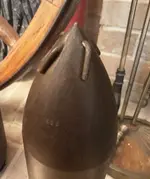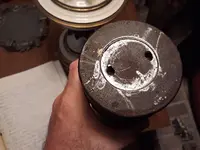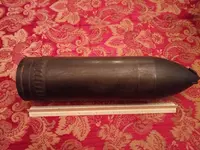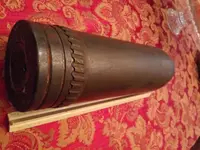Ffuries wrote:
> Maybe PM Thecannonballguy and see if he has any ideals, suggestions or input.
No need for a PM. I've been watching this discussion for a while. As I've said previously, I do not know as much about post-1900 artillery projectiles as I do about pre-1900 ones. So I've just been listening here, to learn from what other readers might be able to tell us about this date-marked 1909 artillery shell.
But since you want my input, I'll speak up.
The "nose wires" purpose has nothing to do with fuzing or a "safety." This shell's fuze is in its base. The screw-in disc there, with two round holes for a spanner-wrench, is typical of late-1800s/very-early-1900s base fuzes.
The extensive markings on the shell are very much NOT typical. Being so extensive suggests this is an Experimental shell, specially marked for the purpose of record-keeping and "tracking" in the after-testing report about its performance.
The human hand in the first photos told me the marking with an "8" did not mean 8-inch caliber, but instead, something more like 3.8-inch caliber. In the very first reply in this discussion, NOLA_Ken requested measurement of this shell's diameter... and he and I are still waiting for that information.
The three-digit number (629) stamped into the side of this shell's nose is also completely un-typical for an "ordinary" projectile. I've seen a two- or three-digit number at the nose's side on many Museum specimens, such as those in the artillery projectile collection at West Point, USMA (United States Military Academy).
At first impression, the only purpose I could think of for the four kinda-thin wire-like prongs spaced at 12, 3, 6, and 9-o'clock around the tip of this shell's nose is that they were somewhat like the copper stud in a civil war Dahlgren Blind-Shell's nose... intended to transmit armor-impact heat to ignite the shell's bursting charge a fraction of a second after it penetrated the armor. But a second thought soon came. In the 40-or-so-years between the civil war and 1909, enormous progress had been made in armor-piercing fuzes. By then, it seems extremely unlikely that somebody would try reverting to that long-obsolete principle of armor-piercing shell fuzing.
So, all I can say about those 4 "wires/prongs" is that I notice they appear to be bent downward at slightly different angles. Therefore, I think they were pointing straight outward, or upward, before the shell was fired. Being bent downward at a side-slanting angle indicates they got bent when the spinning projectile struck the target.
NOLA_Ken asked:
> If the shell is hollow do the pins go into the hollow area?
I'm reasonably sure they do not go into the shell's powder-cavity, because they are very-very close to the tip of the nose, and the powder-cavity never goes up that close to the tip of the nose. (If it did, the "shellwall" of the nose-tip would be EXTREMELY thin, which makes it useless as an armor-piercer.)









